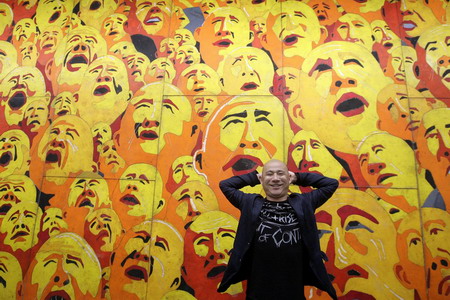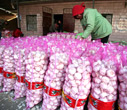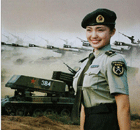Highlights
China art market soul-searching as prices plummet
(Agencies)
Updated: 2009-10-12 09:30
|
 A man looks at an art work named "Black Bird" by artist Lu Zhengyuan at the Green Art Fair, which showcases young Chinese artists, in Beijing in this September 22, 2009 file photo. [Agencies]
|
HONG KONG: The fallow plots of farmland on the edge of the artists' village of Songzhuang are a symbol of Chinese contemporary art's recent boom and bust cycle.
When prices for Chinese art soared, there were grand plans to build more galleries and studios in this artists' hamlet near Beijing. Yet today, after art prices plunged by some 60 percent in the past year, the expansion plans have floundered.
After a white-hot stint, the financial crisis has battered China's art landscape, shrinking investment in grand schemes like Songzhuang, shuttering galleries in Beijing's pioneering 798 arts district and deflating bloated egos, valuations and excesses.
"The Chinese contemporary market was over-swollen before. I felt it wasn't very healthy," said Nan Xi, a former Chinese army officer turned artist whose works, huge pointillist ink-brush canvasses which he displays in his spacious Songzhuang villa, fetched around half a million yuan at the peak of the market.
In the good days, ferocious bidding in auction rooms at the market's peak in 2007 and 2008 caused prices to spiral skyward with buyers and speculators treating contemporary artwork almost like stocks or tradeable commodities.
What resulted was a glut of average art at inflated prices and a growing community of millionaire artists, some more drawn by the opportunities to make vast amounts of cash than any artistic vision.
"The financial crisis has been a good lesson for us; to better know what the market is, and art's relationship to it. Having too much money is not good for an artist's development," said Nan.
Reasonable Prices
China's leading auction house, Beijing Poly International Auction, which is famous for its repatriation of looted bronze animal heads from the West, has seen business in Chinese contemporary art plunge over 50 percent in the past year.
"A lot of buyers have been pushed out, including the speculators. The collectors who are left are now able to pay more reasonable money for reasonable things," said Li Da, Poly's general manager.
He gives the example of a large Zhang Xiaogang bloodline painting which fetched 16.8 million yuan ($2.5 million) in May and says that painting would have sold for more than twice that amount if it had been auctioned in 2007.
Melancholy canvasses by Zhang, one of China's A-list artists which includes the likes of Liu Xiaodong, Zeng Fanzhi, Fang Lijun, Cao Guoqiang and Yue Minjun, sold at up to $6 million a piece at the market peak.
|
 Chinese artist Fang Lijun poses in front of his painting in Taipei in this April 17, 2009 file photo. [Agencies]
|
Those valuations have, like many others, since fallen some 66 percent according to an index on Chinese art website Artron.net.
Since 2007, the overall market for Chinese contemporary art has shrunk over 54 percent according to Artron.







